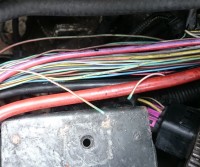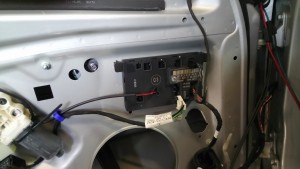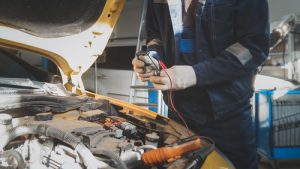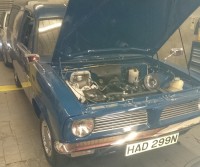Summer season is here
With the weather getting warmer we are starting to see more cars with A/C issues. Here is a Peugeot RCZ […]
READ MORE - Do you need a reliable Car Electrics Specialist in Liverpool?
Do you need a reliable Car Electrics Specialist in Liverpool?Car Electrics Liverpool – Our team of auto electricians Liverpool, Widnes, Warrington, St Helens based are fully trained in identifying and repairing most vehicles’ electrical problems. We use specialised equipment to take readings from vehicles to identify any electrical fault, and once identified we can then repair or replace the faulty part.
We offer a range of services including installations, rewiring, diagnostics, alternators, fitting service, testing service, engine management, fuel injection, fault finding, car alarms, immobilisers, and central locking systems.
Car Electrics Widnes 2020 – Here at Widnes Auto Electrical we specialise in Car Electrical Repairs in the Widnes area, from our family-run garage in Widnes, just located 2 minutes away from the Runcorn Bridge. We specialise in many different aspects of Car Electrics Widnes including:
Although if your fault isn’t listed here, then that doesn’t necessarily mean that we can’t fix it, it may just be one of the more un-common problems that we face every now and then. We are experts in our field of work and when you come to us for any Electrical Repairs, you can be sure that you’ll be getting the best possible service and best of all, it won’t cost you an arm and a leg either!
So call us today or contact us through our website if you’re interested in what we can do for you regarding Car Electrics Widnes, once we’ve been contacted, we can either offer you a quote, extra-information, how long it’ll roughly take to fix and we’ll even arrange a time and date for you to bring your vehicle down to us. Remember for Car Electrics Widnes, Widnes Auto Electrical Services are the number 1 choice in the Widnes & Halton area.

 Is wiring a vehicle easy to do?
Is wiring a vehicle easy to do?Cars are complicated. Especially engine – it needs to be fed the proper amounts of air, fuel, and spark. The suspension and brakes must be in tip-top shape. The wheels and tires, transmission, cooling system, gauges—even the seats—must all function properly. With all these being really important, many often neglect the importance of the vehicles electrical wiring system.
Poor wiring will keep your electrical components from operating at full potential. Many people would never consider the idea of wiring a vehicle. It can be daunting. — so we’ve put together a few tips to help you understand the basics.
Round Up The Right Tools – Start with a quality set of wire strippers – they will usually include a group of holes to fit most wire gauges. This enables the stripping of the insulation off your wires without accidentally cutting into the wire conductors. A wire cripper is necessary when you install solderless connectors. Most quality crimpers have two or three sections on the nose to fit various lug sizes. You can even get crimpers with wire cutting and wire stripping sections.
A soldering Iron is needed for splicing wires or securing oversized connectors that cannot be crimped. You will need solder designed specifically for electronics and wiring . Here are some other items that should be in your electrical toolbox:
Gauge Your Wiring Needs
A factory wiring harness includes the necessary wiring for standard electrical components like windshield wipers, horn, headlights, etc. However, when you add electrical or electronic components to your vehicle, like high-end audio or racing electronics, you need to choose the proper wire on your own. There are three factors to consider: size, material, and color.
Wire size is measured by gauge—the smaller the gauge number, the larger the wire. The gauge you need depends on the current draw of the accessory and the wire length between the accessory and the power source. In general, the larger the current draw, the larger gauge wire you need to properly power the accessory.
One factor to consider with long lengths of wire is voltage drop. The longer the wire, the greater the voltage drop. You can offset voltage drop by increasing the size of the wire. As a rule of thumb, try to maintain a less than 0.5% voltage drop to assure maximum performance.
Wire material is usually aluminum or copper. For automotive purposes, we recommend stranded copper wire for the greatest flexibility and conductivity.
Wire color may not seem important at first glance, but it becomes crucial when you try to trace a faulty circuit down the road. To keep yourself from tearing your hair out, color-code your wire by accessory. It will help you keep track of which wire goes where during installation and troubleshooting.
Make the Connection
There are two main types of connectors: soldered and solderless. Soldered connectors are necessary with oversized wiring or if you’re splicing wires together. Solderess, or crimp, connectors can be used for most other wiring, and we’d recommend using them wherever possible.
Solderless connectors are the easiest to use and provide a good, strong connection. Usually, solderless connectors come with color-coded insulators, so you know which gauge wire they are designed for. Solderless connectors come in a variety of configurations:
Butt connectors are shaped like cylinders and are ideal for joining two wire ends together. A wire end is inserted into each end of the connector, which is crimped to complete the connection.
Spade connectors are ideal for components that are removed or serviced often. A male connector on one end of the wire fits into a female connector on the other end of the wire, completing the connection. To disconnect, just pull the connectors apart.
Ring connectors are used to secure wire to screw-type terminals; they are secured by the terminal screw.
When installing any type of connector—soldered or solderless—it is a good idea to use shrink tubing. Shrink tubing is relatively easy to install and provides added protection against electrical shorts and outside elements.
Choose the Right Components
There is more to wiring a vehicle than, well, wire. For example, you will need some sort of overload protection to protect your expensive electronics. The three basic types of overload protection are fuses, fusible links, and circuit breakers:
You should also install relays with your wiring if your electrical accessories require a bigger current draw than a standard power switch is rated to handle. And since most switches are designed to work with very limited currents, relays are required just about every time to wire a new aftermarket electrical accessory.
Relays are extremely useful for handling high-amperage electrical accessories like large electric fans, fuel pumps, and HID headlights. They are activated by an electric coil and controlled by a switch. When the relay is closed, no power goes to the accessory in question. When you flip the accessory switch, an electric coil in the relay opens, sending power to the accessory.
There are plenty of other products to make your wiring tasks easier, including switch panels, multi-circuit main and auxiliary fuse blocks, toggle, push-button, and remote-mount switches, and of course, wiring harnesses for everything from fog lights and gauges to complete vehicles.
Map Out a Plan
Before you begin your wiring project, map out a plan. Lay out the wiring or wiring harness so you know where each wire goes and that you have enough wire to complete the job. Locate the fuse box in an easy to reach location like your glove compartment or center console. Place the necessary relays, fusible link, or circuit breakers at connections between your power source and your electrical accessory.
If the wiring isn’t labeled already, label each wire or harness with the name of the components they route to. If the wiring or harness will be going through the firewall, use a grommet in the hole so the sheetmetal won’t cut through the wires. Don’t secure the connectors until the wiring is through the firewall.
Choose a spot on or near the firewall for the common ground point for the harness, and one point for a chassis ground on the negative side of the vehicle. This method gives you a single path to the negative side of the vehicle and provides a more effective ground. Use 10 gauge or bigger wire to connect the common ground to your chassis ground.
Please note these are only tips. We in no way recommend doing this if you are not confident or qualified in this field. If you are unsure, then please do get in touch and we will be happy to help
There is always a general basic safety procedure to follow if you want to make sure your car problems are kept to a minimum. Not only will it help you hold the long term value of your vehicle but it will also help you stay safe whilst on any long or short journeys
The minimum legal limit on your tyres is 1.5mm. This is the point at which your tyres become illegal. That said, it’s really important that you check them sooner. The last thing you want it is to find you are over this point. It could prove costly getting your car to the garage since it is illegal to drive at this point. If there is rain, ice, snow etc. then below 2.0mm could see your tyres losing grip and become dangerous to drive.
The pressure in your tyre is equally as important. Tyre manufactures typically have different pressure guidelines. It’s important to check your manual to ensure you keep them to the optimum given. If your tyre pressure is not right, you could lose grip or worse still have a blowout whilst driving. This is both costly and dangerous. Make sure you always check your tyre pressure and your tread depth.
If you share a car with someone else, it’s likely that your mirrors, will have been adjusted. The last thing you want whilst driving along is to fiddle around trying to adjust them. This could lead to a crash. Same with the window wipers. If you are driving in heavy rain and they are not working, or the blades are broken you may struggle to see where you are going. The last thing you want is an accident that could have been avoided
Don’t take the car electrics for granted. With modern cars becoming more and more controlled by sophisticated on board computers, it’s becoming more important to watch out for electrical faults. From your windows, to your starter motor, there are now very few parts of your car unaffected by this move towards the electric first approach to driving a car. If you see any warning lights on, it’s important that you head to your local auto mechanic to ensure there is nothing seriously wrong with your car. The last thing you want is for you to be stranded in the middle of nowhere because your car will not start.
These are just a few safety tips that we have highlighted. If you are concerned about how to ensure you stay safe on the roads, feel free to give us a call. The team at Widnes Auto Electrical are always happy to help.
Making or receiving a call, even using a ‘hands free’ phone, is illegal. The fixed penalty for being caught using a handheld phone in the car is a £200 fine and six points on your licence since 1 March.28 Feb 2017. Moeverover it can distract your attention from driving and could lead to an accident.
In a collision, an un-belted rear passenger can kill or seriously injure the driver or a front seat passenger. Make sure everyone is wearing their seatbelt
Being in charge of a vehicle while above the legal limit or unfit through drink
You may get:
At 35mph you are twice as likely to kill a pedestrian as at 30mph. The minimum penalty for speeding is a £100 fine and 3 penalty points added to your licence. You could be disqualified from driving if you build up 12 or more penalty points within a period of 3 years.
Children often act impulsively, take extra care outside schools, near buses and ice cream vans when they might be around. Make sure you guide them safely into and out of your vehicle at all times.
Tiredness is thought to be a major factor in more than 10% of road accidents. Plan to stop often and for long enough to help you feel more alert
Be aware of the roads around you. Vehicles may not always see you in built up areas. Don’t just step out onto the road. Check and use safe crossings at at all times
Observe and anticipate other road users and use your mirrors regularly.
Child and baby seats should be fitted properly and checked every trip.
Keep the right distance. If you don’t know what this is then revisit your highway code and checking your stopping distance.

 Winter advice for keeping your motor running in the cold
Winter advice for keeping your motor running in the coldWhen it starts to get a little chilly, as it often does in the UK, it’s not uncommon to find your car not running as it should. For things like starter motors, car batteries, and alternators, damp and cold conditions can caused issues.
Battery Problems – The most common fault tends to be the battery. If you hear a faint notice when you try to turn the ignition it could be that you have a flt battery. You might want to check your dashboard lights. If they are not coming on this is a sign that there may be an issue with the battery. To prevent this from happening it may be worth charging your battery
Alternator Problems –If you have a new battery and it keeps going flat, the problem probably lies here. When you jump start your car and the engine dies immediately, this points to a faulty alternator. Another sign with an issue with the alternator is that your dashboard lights and possibly your headlights will flicker. In these situations, it’s recommended to book your vehicle in with an experienced auto electrician. Where electrics are involved it’s always better to be safe than sorry.
Broken Starter Motor – The most obvious sign of a broken starter motor is a clicking sound when you turn the ignition key, followed by the engine refusing to start. You can usually tell if it’s the starter motor rather than the battery at fault if all the lights and in car electrics are working. Similar to the alternator, because you are dealing with electrics, it’s always better to visit a professional auto electrical specialist.
Using the wrong oil – If your oil has too much cold viscosity (resistance to flow), you won’t be able to start your car in cold temperatures. On the flip side, excessive hot viscosity means engine components won’t be adequately protected, leading to premature wear. A good idea here would be to check your car’s handbook to see what type of oil the manufacturer recommends, and switch to a thinner grade if possible in winter. It’s not usually for this simple tip to be the difference between a trip to see your mechanic and keeping your car healthy in the winter months
Find an Auto Electrician near you – If you are experiencing any of these problems or just want to make sure your car is running to its best during the winter, its always recommend that you take your car in to a professional mechanic. If you live in or around Widnes and want to get your car electrics checked out then the team at Widnes Auto Electrical would be more than happy to help.

Car electric faults – The electrical systems in new cars have definitely made driving a lot easier over the decades. The seemingly endless innovations in electrical systems have helped us enjoy a more comfortable and easier drive. However they can still suffer problems just like older vehicles.
Here are some of the issues that you could face with a new vehicle’s electrical system:
Car’s Battery Is Dead – This is the most common problem…and most obvious. Check your battery by engaging your headlights and judge by the illumination.
No Power Stored in the Battery – When you turn the key, what do you hear? A little click? Does it sound like it wants to turn over? It is possible that your car’s battery does not have ample power to crank the starter. You need a new battery.
Alternator is Not Working – A damaged or broken alternator could be the culprit. No alternator? No battery recharge. If your car suddenly start to lose “juice” while drive, you’ll know it could be your new car’s alternator.
Problem with Starter or Solenoid – Good parts gone bad parts. If it’s the starter, it won’t turn over. If you have Solenoid issues, you might find it harder to brake.
Battery Cables Might Be The Problem – A loose cable might be the root of the problem…give them a wiggle before you run out and buy a replacement.
Electrical Fuses – Check for any blown fuses in your fuse box. Also, feel around for any loose wires.
Cracks In Alternator Belt – Too much or too little tension, as well as cracks in the alternator belt cause trouble.
Ignition System Has Problems – You have a busted ignition switch. Give your mechanic a call.
Loose Spark Plugs – Loose or old plugs will certainly affect the operation of your vehicle. Are you losing power as gears change? Does it lurch as if the gears aren’t engaging? It might be the internal combustion and the culprit is usually the plugs and cables.
If you are facing any of these issues, with a new car, or an old, then we definitely recommend you go to your local auto electrician to get a proper diagnosis. It may just save you money in the long run. Especially if your new car is still under warranty.
>